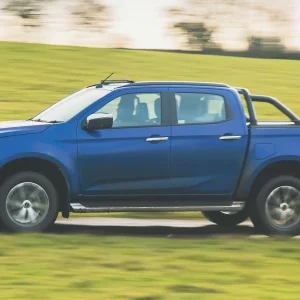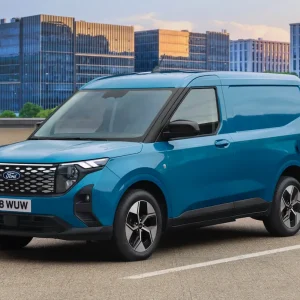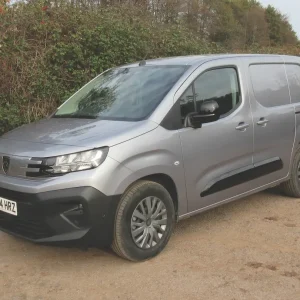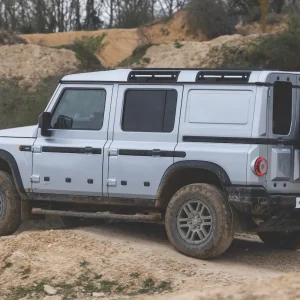The UK’s big supermarket chains are increasingly contemplating switching to zero-emission battery-electric 3.5t vans for home delivery work. Range limitations and the constraints imposed by the charging infrastructure mean that they are not yet suitable for all applications, however, so diesel is still likely to be favoured for much of the work that the fleets handle.
Home delivery is a harsh environment for vans, with clutches taking a real hammering. As a consequence, more home delivery companies are specifying diesels with multi-speed automatic boxes, and Mercedes-Benz’s Sprinter is attracting much of the business.
Not surprisingly, other manufacturers are hoping to snaffle a piece of the pie. Iveco has made some progress with the Daily, Volkswagen is hoping to do the same with the automatic Crafter that was tested in the May issue, and Ford is aiming to get a foot in the door with its 10-speed automatic rear-wheel drive Transit. The same box is deployed in the Ranger pick-up and the Mustang car.
Unfortunately, the big Blue Oval has taken rather too long to launch it in Transit, just as it has been behind the curve with the introduction of the electric Transit. Good news if you happen to be selling Sprinters, and there seems little doubt that Mercedes-Benz’s offering has been putting the Transit under pressure.
Ford has of course been offering front-wheel-drive Transits with a six-speed auto box for some time. Not all home delivery fleets want to go the front-wheel-drive route however, and the six-speed box is somewhat long in the tooth.
It was with these thoughts in mind that we took to the highway in a rear-wheel-drive Ford Transit 350 L2 H2 in Limited trim, powered by a 170hp 2.0-litre EcoBlue diesel married to the 10-speed auto transmission. How did we fare?
Load bay
Entry to the van’s 9.5m3 cargo area is through a sliding nearside door that opens to reveal a grab-handle and a step with a tie-down point in the step well. Rear entry is by means of twin doors that can be swung through 90º.
They can be pushed through 180º once the stays are unfastened. All you need to do to release each of them is push a button, so no risk of pinching your fingers.
A step aids rear access, but no grab handle is provided – an unfortunate oversight.
A full-height steel bulkhead divides the cab from the well-lit load bay, which boasts 10 load lashing rings. Panelling defends the cargo box’s sides, doors and wheel boxes against scratches and scrapes, and the load bed is protected by a tailored cover.
Payload capacity is not outstanding for a 3.5-tonner and you may want to consider opting for a manual gearbox if you are doing weight-sensitive work.
Interior and equipment
The Transit’s three-seater cab does not lack storage space.
There are no less than four shelves on top of the dashboard, one of which plays host to a 12v power point and a USB socket. Both are duplicated in the centre of the fascia.
There is shelving at the top of the Quickclear heated windscreen and a roomy, lidded and lockable glove box with a shelf above it.
Glance down and you will spot a holder for an A4 clipboard, to the left of and below the moulding that accommodates the gear shift.
There are good-sized cup holders at each extremity of the fascia and big bins are mounted on each of the doors, with the one on the driver’s side featuring a moulding shaped to embrace a bottle or flask.
For some reason, the one on the passenger side doesn’t – a curious omission.
Beneath the bin on the driver’s door there is a compartment with a cover held in place by studs. It can accommodate an optional first aid kit.
The mid section of the centre seat’s back can be flipped down and transformed into a useful desk. It features a tray for your pens, two cup holders and an elasticated strap to keep your paperwork in place.
A stowage area concealed beneath the passenger seat cushions is ideal for hiding smartphones, valuable tools and other items that you don’t want to lose to the light-fingered.
Incorporating lumbar adjustment and an in-board armrest, the driver’s seat is height-adjustable. So is the leather-trimmed steering wheel, which plays host to the DAB radio’s remote controls.
In-cab kit includes manual air-conditioning, a driver’s airbag – you’ll pay extra for passenger and curtain airbags – and an 8in TFT touchscreen in the centre of the dashboard with Bluetooth connectivity.
Ford SYNC is provided, which ties in with compatible smartphones and enables drivers to use either the touchscreen or voice commands to control everything from texts and phone calls to satellite navigation and music. AppLink enables SYNC-compatible apps to be controlled.
Emergency assistance helps the driver call for rescue in the event of a collision and is able to pinpoint the van’s precise location.
Electrically adjustable, heated and folding exterior mirrors are fitted; each comes equipped with a fixed lower wide-angle section.
Reversing sensors are provided as well and can be turned off. Sensors are fitted at the front to make parking in tight slots less stressful, and this Transit comes with side park assist to make life even simpler.
Ultrasonic sensors alert you if your vehicles sides are getting perilously close to an obstruction and are at risk of suffering damage.
A heated windscreen and rain-sensing windscreen wipers form part of the package, as do front fog lights and bright Bi-Xenon headlights with LED daytime running lights. The headlights illuminate automatically when the daylight fades.
The plethora of onboard safety systems includes ABS, electronic stability control, electronic brakeforce distribution, hill start assist, emergency brake assist, emergency brake warning and roll stability control. Also present and correct are side wind mitigation, cruise control with adjustable speed limiter, and traction control system, which can be switched off.
The Transit’s independent front suspension encompasses independent MacPherson struts with variable-rate coil springs and a stabiliser bar. Leaf springs help support the rear, and gas-pressurised shock absorbers are fitted all round, as are disc brakes.
Our Transit’s 16in alloy wheels wore Michelin Agilis 235/65 R16C tyres.Electric power-assisted rack-and-pinion steering delivers an 11.9m kerb-to-kerb turning circle.
Powertrain
Featuring common rail direct fuel injection, Transit’s turbocharged 16-valve four-cylinder in-line diesel produces maximum power output at 3500rpm. Maximum torque of 390Nm bites across a handily-broad 1750–2500rpm plateau.
Diesel Transits make use of a diesel particulate filter and Selective Catalytic Reduction to meet the Euro 6 exhaust emission standard, and SCR relies on AdBlue. The top-up point that feeds the 21-litre reservoir is beneath a flap close to the passenger door along with the capless Easy-Fuel diesel filler point.
Driving
Our Transit handled remarkably well, clinging determinedly to the highway as we pushed it hard through bend after bend and showing no inclination to come unstuck.
The presence of curve control undoubtedly helped. It is there to make sure you stay in control of your vehicle if you take a bend too rapidly. If it detects under-steer and suspects everything is about to go pear-shaped then it reduces engine torque and applies the brakes to help bring your speed down.
Nor was the Transit short on performance, although there were one or two occasions when we felt the automatic transmission’s kick-down facility could have been a bit more aggressive.
Otherwise, the auto box was a treat, nipping briskly and smoothly from one gear to the next without a hint of jerkiness.
It was biddable during low-speed manoeuvring too. At no point did it cause the van to jolt suddenly or hurtle forwards unexpectedly.
If you feel you want to then you can push the transmission lever to M for Manual, then flick a switch on the side of the lever every time you want to go up and down the box. It’s an easy enough system to use, but we suspect most drivers will leave the box in its automatic setting for the majority of the time and let it get on with things.
Drawbacks
Ford needs to pay more attention to managing in-cab noise levels, especially so far as the engine and transmission are concerned. Wind noise was an issue too, and we were concerned about the level of vibration at tick-over.
Build quality needs tightening a little to match the – admittedly extraordinarily high – standards set by the Crafter and Sprinter.
While our test Transit rode well, there was a bit too much thumping and bumping from the suspension even on smooth road surfaces.
Resorting to the Eco setting on the mode switch should help keep diesel consumption down. Pressing it modifies the Transit’s torque setting and rate of acceleration among other functions. As a consequence, fuel usage should fall by approximately 10% says Ford.
The switch’s Slippery option changes the electronic stability control and traction control settings to provide enhanced grip in several weather conditions, such as ice, snow and mud.
Operating
Transit is covered by a three-year/ 100,000-mile warranty. Service intervals are set at two years/25,000 miles.Ford has suggested that Transits should undergo a one-year/10,000-mile interim workshop inspection. Who knows what damage may have been inflicted on the tyres, wheels, suspension and steering by the UK’s pot-holed motorways?
Remember that the Transit comes with a handy on-board maintenance monitor. It tells you everything from how much life is left in the engine oil to whether your AdBlue reservoir needs topping up.
Fuel economy? We achieved a steady 28mpg, rather better than the WLTP overall figure of 25.9mpg that Ford cites. We would probably have done better had we remembered to press the Eco button.
Deep side rubbing strips helped defend the Transit’s optional metallic paint against minor bumps and bangs.
Our Transit was not equipped with a spare wheel, but had a tyre inflator kit stowed under the driver’s seat instead. While such an approach gives you slightly more payload capacity, it’s not a lot of help if the damage inflicted by one of the aforementioned potholes is so severe that the tyre concerned is no longer capable of being inflated.
Ford Transit Limited 350 L2 H2 2.0L EcoBlue HD 10-speed auto 170hp RWD
Price (ex VAT) £41,235
Price range (ex VAT) £28,605-£45,100
Gross payload 1,203kg
Load length 3,044mm
Load width (min/max) 1,392mm/1,784mm
Load bay height 1,786mm
Load volume 9.5m3
Loading height 706mm
Rear door aperture 1,565mm x 1,648mm
Side door aperture 1,300mm x 1,600mm
Gross vehicle weight 3,500kg
Braked trailer towing weight 2,800kg
Engine size/power 1,996cc, 170hp @ 3,500rpm
Torque 390Nm @ 1,750-2,500rpm
Gearbox 10-spd auto
Fuel economy 25.9mpg (WLTP overall)
Fuel tank 70 litres
CO2 305g/km
Warranty 3yrs/100,000mls
Service intervals 2yrs/25,000mls
Insurance group 47A
Price as tested £41,885
Options
Metallic paint £650
Rivals
Mercedes-Benz Sprinter
Price (ex VAT) £27,345-£57,965
Load volume 7.8-17m3
Gross payload 731-2,529kg
Engines 150hp, 170hp 2.0 diesel, 143hp, 163hp 2.1 diesel, 190hp 3.0 diesel, 85kW electric motor
Verdict: Van operators who value safety and connectivity should head straight for Sprinter. Solidly-constructed and with a reputation for durability, it comes with the choice of two automatic transmissions, although neither of them are 10-speeders. A seven-speeder is optional on rear-wheel drive variants while a nine-speeder can be specified on its front-wheel drive stable mates. Look out for the electric model, which is now available.
Fiat Professional Ducato
Price (ex VAT) £27,005-£75,570
Load volume 8-17m3
Gross payload 690-1,885kg
Engines 120hp, 140hp, 160hp, 180hp 2.2 diesel, 90kW electric motor
Verdict: Sharing the same basic design as Citroen’s Relay and Peugeot’s Boxer, and recently revised, Ducato is available with a nine-speed automatic gearbox. The new electric model is well worth a look, with the choice of two battery packs and a claimed range of up to 230 miles between recharges. Citroen, Peugeot and Fiat Professional are all owned by global automotive conglomerate Stellantis.
Volkswagen Crafter
Price (ex VAT) £28,405-£45,505
Load volume 9.3-18.4m3
Gross payload 761-2,472kg
Engines 102hp, 122hp, 140hp, 177hp 2.0 diesel
Verdict: Crafter has always languished in the shadow of Mercedes-Benz’s Sprinter. That’s a pity, because it is just as well put together as the three-pointed star’s offering, with the same emphasis on safety and durability. Crafter is also marketed by MAN as the TGE, and MAN has stolen a march on VW by getting an electric TGE onto the UK market. An e-Crafter had yet to appear on this side of the Channel at the time of writing.
The Final Verdict
Design 8/10 – A practical workhorse that ticks almost all the boxes.
Cabin 8/10 – Well-equipped, with lots of storage space and comfortable seating.
Ride 8/10 – Better than what is on offer from many of the Transit’s rivals.
Refinement 6/10 – In-cab and suspension noise levels were too high and build quality
needs tightening up a little.
Load area 7/10 – Plenty of tie-down points and a beefy bulkhead, but rear door
pillars should be fitted with grab-handles.
Handling/performance 7/10 – Both are to a high standard, although we’d have welcomed more urgency from the auto box’s kick-down facility.
Engine/transmission 9/10 – Well matched, with Ford’s usual slick gear change worthy of applause.
Standard equipment 8/10 – Opt for Limited trim and you get almost all the goodies you are likely to need. Side park assist is a definite plus.
Operating costs 7/10 – Sensible warranty should help keep expenditure down and Transit residual values are invariably healthy. Fuel economy is respectable but not outstanding.
What Van? subjective rating 7/10 – Nobody ever got shot for buying a Transit. It should certainly be on your shopping list – but Mercedes-Benz’s Sprinter may be edging closer to the top.
Overall Rating = 75/100





